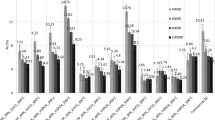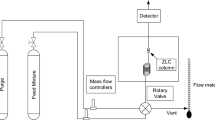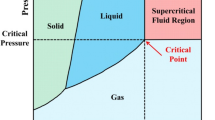Abstract
Bubble size is a key variable for predicting the ability to separate and concentrate proteins in a foam fraction ation process. It is used to characterize not only the bubble-specific interfacial a rea but also coalescence of bubbles in the foam phase. This article describes the development of a photoelectric method for measuring the bubble size distribution in both bubble and foam columns for concentrating proteins. The method uses a vacuum to withdraw a stream of gas-liquid dispersion from the bubble or foam column through a capillary tube with a funnel-shaped inlet. The resulting sample bubble cylinders are detected, and their lengths are calculated by using two pairs of infrared photoelectric sensors that are connected with a high-speed data acquisition system controlled by a microcomputer. The bubble size distributions in the bubble column 12 and 1 cm below the interface and in the foam phase 1 cm above the interface are obtained in a continuous foam fractionation process for concentrating ovalbumin. The effects of certain operating conditions such as the feed protein concentration, superficial gas velocity, liquid flow rate, and solution pH are investigated. The results may prove to be helpful in understanding the mechanisms controlling the foam fractionation of proteins.
Similar content being viewed by others
Abbreviations
- A :
-
internal cross-sectional area of capillary tube (m2)
- d b :
-
bubble diameter (mm)
- d c :
-
inside diameter of capillary (m)
- l b :
-
length of bubble slug (m)
- l c :
-
capillary tube length (m)
- p :
-
pressure at detection point of capillary (Pa)
- p A, po :
-
pressure at sampling point of dispersion (Pa)
- P v :
-
pressure at capillary tube outlet, or vacuum pressure (Pa)
- S b :
-
cross-sectional area of a bubble slug (m2)
- S k :
-
cross-sectional area of a capillary tube (m2)
- t *b :
-
time for bubble slug to pass detection point on capillary tube (s)
- U *b :
-
bubble velocity at detection point (m/s)
- V b :
-
bubble volume in dispersion (m3)
- z :
-
distance between point of observation and outlet of capillary tube (m)
- μ:
-
dynamic viscosity (Newton-seconds/m)
- ρ:
-
fluid density (kg/m)
- σ:
-
surface tension (N/m)
References
Greaves, M. and Kobbacy, K. A. H. (1984), Chem. Eng. Res. Des. 62, 3–12.
Weiland, P., Brentrup, L., and Onken, U. (1980), German Chem. Eng. 3, 269–302.
Barigou, M. and Greaves, M. (1991), Meas., Sci. Technol. 2, 318–326.
Gao, D., Xu, Z., and Zhang, J. (1986), J. East China Inst. Chem. Technol. 12 (Suppl.), 115–126 (in Chinese).
Yu, B., Deng, X., and Shi, Y. (1988), J. East China Inst. Chem. Technol. 14(5), 588–596 (in Chinese).
Jiang, H. and Gao, D. (1988), J. East China Inst. Chem. Technol. 14(5), 597–604 (in Chinese).
Zhang, Z., Dai, G., and Chen, M. (1989), J. Chem. Eng. Chim. Univ. 3(2), 42–49.
Uraizee, F. and Narsimhan, G. (1995), in Bioseparation Processes in Foods, Singh, R. K. and Rivzi, S. S. H., eds., Marcel Dekker, New York, pp. 175–225.
Uraizee, F. and Narsimhan, G. (1996), Biotechnol. Bioeng. 51, 384–398.
Calvert, J. R. and Nezhati, K. (1987), Int. J. Heat Fluid Flow (8(2), 102–106.
Magrabi, S. A., Dlugogorski, B. Z., and Jameson, G. J. (1999) Chem. Eng. Sci. 54, 4007–4022.
Brown, L., Narsimhan, G., and Wankat, P. C. (1990), Biotechnol. Bioeng. 36, 947–959.
Wong, C. H., Hossain, M. D., Stanley, R. A., and Davies, C. E. (1996), in CHEMECA'96, 24th Australian and New Zealand Chemical Engineering Conference Proceedings, vol. 4, Sydney, Australia, pp. 105–110.
Wilde, P. J. (1996) J. Colloid Interface 178, 733–739.
Bae, J. H. and Tavlarides, L. L. (1989), AIChE J. 35(7), 1073–1084.
Wallis, G. B. (1969), in One-Dimensional Two-Phase Flow, McGraw-Hill, New York, pp. 212–314.
Bradford, M. M. (1976), Analyt. Biochem. 72, 248–254.
Lage, P. L. C. and Espósito, R. O. (1999), Powder Technol. 101, 142–150.
Brown, A. K., Kaul, A., and Varley, J. (1999), Biotechnol. Bioeng. 62(3), 278–290.
Tanner, R. D., Parker, T., Ko, S., Ding, Y., Loha, V., Du, L., and Prokop, A. (2000), Appl. Biochem. Biotechnol. 84–86, 835–842.
Hammershøj, M., Prins, A., and Qvist, K. B. (1999), J. Sci. Food Agric. 79, 859–868.
Author information
Authors and Affiliations
Corresponding author
Rights and permissions
About this article
Cite this article
Du, L., Ding, Y., Prokop, A. et al. Measurement of bubble size distribution in protein foam fractionation column using capillary probe with photoelectric sensors. Appl Biochem Biotechnol 91, 387–404 (2001). https://doi.org/10.1385/ABAB:91-93:1-9:387
Issue Date:
DOI: https://doi.org/10.1385/ABAB:91-93:1-9:387




